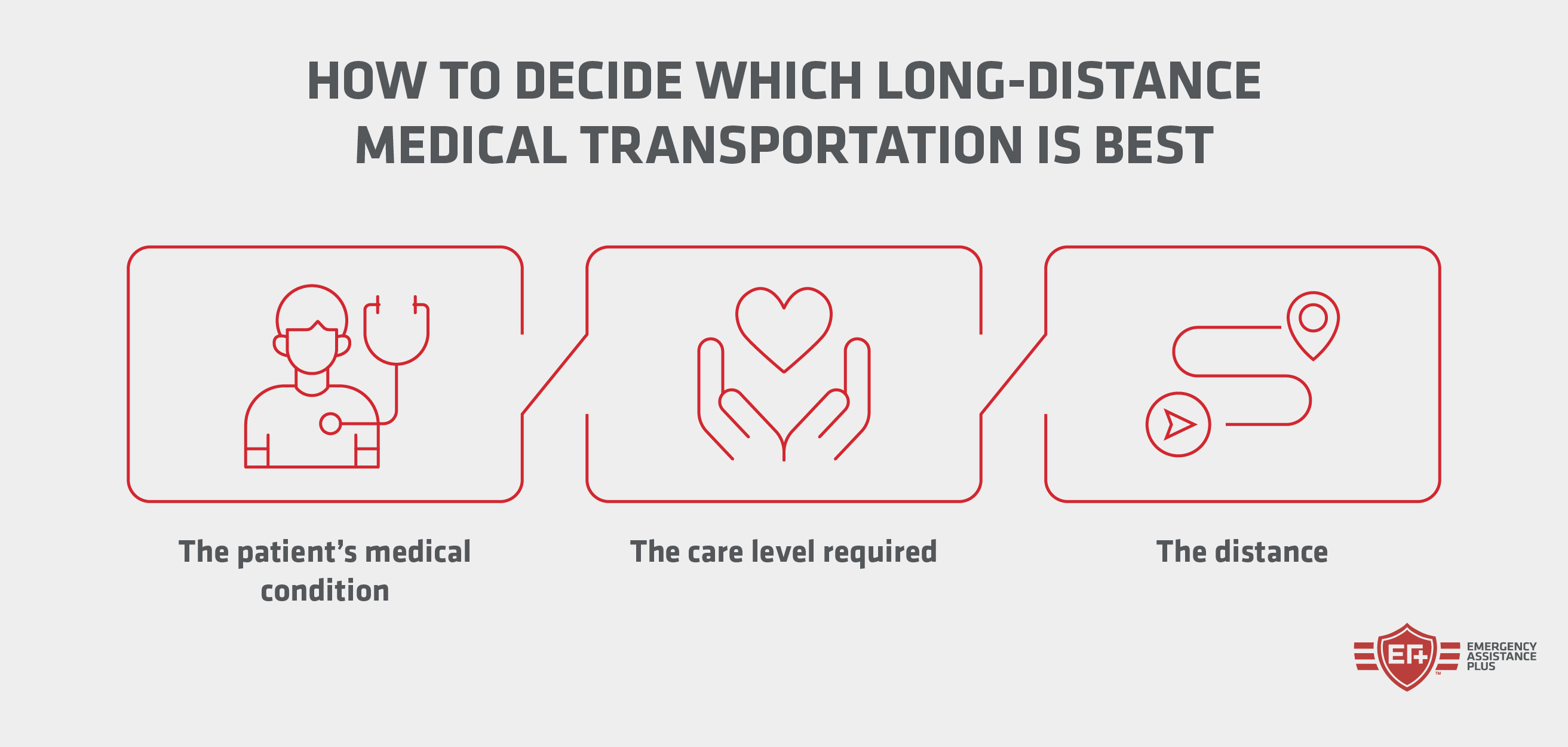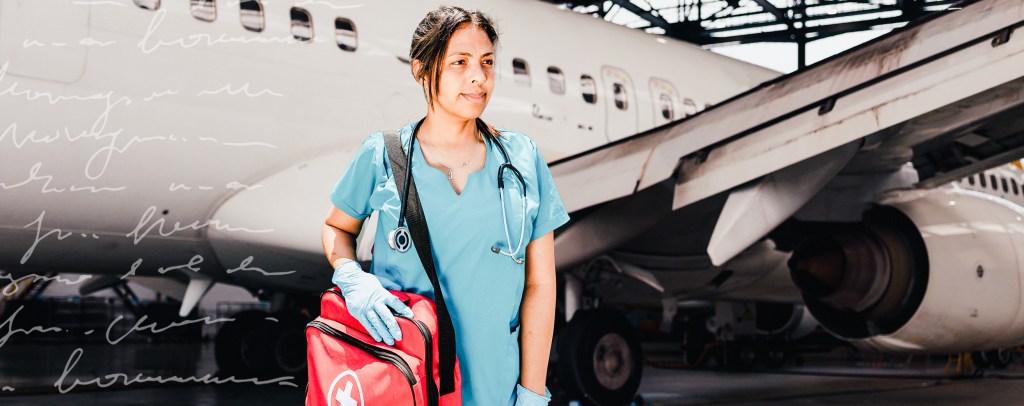Medical Evacuation
On average, long-distance medical transport costs range between $5,000 and $20,000, but depend on various factors like distance, mode of transportation, medical needs, and more.
A sudden fall or accident can turn a dream vacation into a nightmare. Medical emergencies are stressful, but finding specialized travel arrangements can be particularly overwhelming if you’re out of your country or comfort zone.
Ensuring a safe and comfortable travel experience for your loved one should the unthinkable occur may require you to seek long-distance medical transport. Plus, if you’re wondering about long-distance medical transport costs or available options, this is the guide for you.
From evaluating providers to understanding the in-transit care process, we can help you cut through the confusion and find clear, actionable information on coordinating these vital services.
Long-distance medical transport is the movement of medical patients over extended distances, typically farther than 200 miles. This style of medical transportation can vary significantly depending on the type of transportation, but there are a few general things you can expect:
Whether long-distance medical transportation is needed in-country or for medical repatriation, the type of transportation is chosen based on the patient’s medical condition, urgency, travel distance, and the care level required during the transfer. Additionally, teams further enforce travel safety through regular checks and maintenance protocols, establishing a foundation of trust and reliability.

From a beach vacation to a mountain hike, learn how travel assistance works before jetting off.
On average, long-distance medical transport costs are between $5,000 and $20,000, but some types of transportation—like air ambulances and mobile intensive care units (ICUs)—can cost more than $80,000.
Below, we’ve broken down the long-distance medical transport cost by transportation method.
| Transportation method | Base cost | Average cost | Common cost factors |
| Fixed-wing air ambulance | $10,000+ | $12,000–$25,000 per flight | Fuel, Medical staff, Flight crew |
| Helicopter air ambulance | $8,000+ | $10,000–$20,000 | Flight time, Fuel, Call-out fees |
| Commercial airline with nurse escort | $4,000+ | $5,000–$15,000 | Airfare, Medical clearance, Escort fee |
| Non-emergency medical transport | $500+ | $1,000–$4,000 | Equipment, Staff, Level of care |
| Long-distance ground ambulance | $3,000+ | $3,000–$10,000 | Fuel, Meals and lodging, EMT fees |
| Train ambulance services | $2,000+ | $5,000–$10,000 | Ticket expenses, Route availability, Medical Staff |
| Mobile ICU | $5,000+ | $8,000–$20,000 | Critical care staff, Equipment, Patient monitoring |
Navigating long-distance medical transport costs can be as complex as the medical conditions it serves. These costs vary significantly and depend on various factors like:
Requests that require border crossing or longer distances naturally incur higher expenses, and urgent or last-minute requests often come with a premium, reflecting the additional resources needed to accommodate such expedited services.
There are several long-distance medical transportation options to choose from depending on the patient’s medical condition, travel distance, and medical needs, including:
We cover some of the main types of long-distance medical transport available below.

A fixed-wing air ambulance is an aircraft specially equipped to quickly transport sick or injured patients over very long distances and varying terrain. Air ambulances provide medically controlled environments and often include specialized medical equipment like an ICU.
This long-distance medical transport option by air ambulance is ideal when:
The cost of an air ambulance can be great, and it’s not always clear if a standard health insurance plan will cover it. Air ambulance insurance or travel membership assistance can help arrange transport and supplement costs.
Similar to a fixed-wing air ambulance, a helicopter air ambulance quickly transports patients across unique terrain. Medical institutions use helicopters to transport emergent patients in remote locations—especially in areas where ground transportation is slow or nearly impossible and time is of the essence.
Travel assistance and other types of specialized insurance can help offset the costs of a life flight by helicopter.
This December, while finally taking our dream vacation to Fiji, my husband experienced a medical crisis. I immediately called EA+, and I cannot state emphatically enough how grateful I am for the immediate help I received.
Everyone I dealt with was exceptionally proficient in their capacity every step of the way. This was invaluable to me, and I know beyond a shadow of a doubt that this took so much pressure and stress off my shoulders. We had to be medically evacuated to New Zealand for adequate care, and EA+ found an apartment for me that was perfectly located near the hospital and airport.
I am grateful to the team that came in like the cavalry. All was seamless. EA+ is the best and highly recommended!
– Lance N., Louisiana
Commercial flights are often used for non-emergency medical repatriations or when transferring patients over international distances. Many flights can accommodate medical transportation—both sitting and lying down. Plus, a nurse escort (from a medical escort service) can accompany a patient to provide necessary medical support in-flight.
To use a commercial airline as your medical transport:
This type of long-distance medical transportation should only be used by patients with stable medical conditions and the ability to travel at high altitudes.

NEMT services provide transportation for patients who do not require immediate medical care but need assistance getting to and from medical facilities for appointments or treatments. This service is ideal for:
Vehicles used for non-emergency medical transport range from specially equipped vans to ambulances, depending on the patient’s needs.
Check out the long-distance medical transport, including NEMT, plans available to you.
Long-distance ground ambulances are ideal for patients who need basic paramedic support and continuous medical supervision, such as those who require heart monitors, IV fluids, or antibiotics.
This service is available for patients whose destinations are accessible by road, and it uses ambulances equipped to handle longer journeys, providing necessary medical care en route.
In some regions, train carriages are fitted with medical facilities to transport patients. Train ambulances provide a stable and smooth medical environment and are suitable for patients who:
Mobile ICUs are advanced ambulances equipped like a hospital ICU to provide high-level medical care. This mode of transport uses specialized medical personnel to transport critically ill patients traveling to a destination reachable by road. Teams use mobile ICUs when:
Long-distance medical transport can be complicated and costly—from coordinating with multiple parties and sending paperwork and clearances to arranging suitable transportation before and after the medical transport. Often, your need for transportation is also tied to an urgent medical situation, which makes it impossible to interview providers and compare plans.
EA+ during medical emergencies can be a game-changer. As a travel assistance membership, we offer 24/7 access to a network of pre-screened medical providers equipped to arrange and manage medical transport during traveling medical emergencies.
Whether organizing an air ambulance or helping you avoid high transport costs, EA+ works to handle uncertainties so you can focus on what truly matters—your loved one’s health and well-being.
Learn how travel assistance from EA+ is invaluable for long-distance medical transport and discover our commitment to safety, comfort, and professional medical care.
The cost to transport a patient to another state varies widely and depends on factors like the type of transportation method used, the distance traveled, the medical equipment and staff needed, and more.
Medicare Part B, or medical insurance, may cover approximately 80% of ground transportation costs. It’s also possible Medicare will cover part or all of the costs associated with an air ambulance if urgent, non-ground transportation is necessary.
Long-distance medical transportation is suitable for a range of non-emergency medical conditions, including:
Typically, patients on ventilators or with tracheostomies should not use long-distance medical transportation.
Yes, family members can typically accompany their loved one during medical transport to provide emotional support and continuity of care. This is particularly true for parents of pediatric patients. However, depending on the transportation method, there may be space limitations.
To prepare for long-distance medical transport:
These proactive steps help ensure a safe journey for the patient.

Medical Evacuation

Medical Evacuation

Medical Evacuation

Medical Evacuation

Medical Evacuation

Medical Evacuation